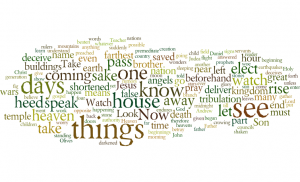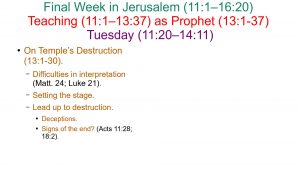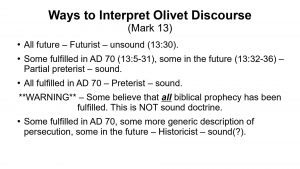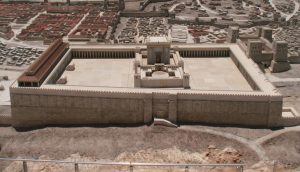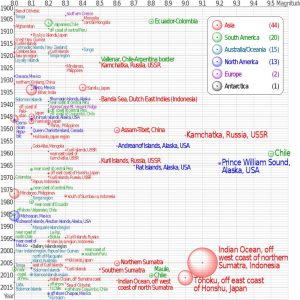Jesus’ Final Week in Jerusalem
Mark 11:1–16:20
Teaching (11:1–13:37)
King (11:1-11)
Sunday: Triumphal Entry (11:1-11).
Lawgiver (11:12–12:44)
Monday (11:12-19).
Tuesday (11:20–14:11).
Lesson from Fig Tree (11:20-26).
Jesus’ Authority Questioned (11:27-33).
Parable of Wicked Vinedressers (12:1-12).
On Taxes (12:13-17).
On Resurrection (12:18-27).
The Greatest Commandment (12:28-34).
An Unanswerable Question (12:35-37).
Warning About the Scribes (12:38-40).
Widow’s mites (12:41-44).
Prophet (13:1-37)
 On Temple’s Destruction (13:1-30).
On Temple’s Destruction (13:1-30).Difficulties in interpretation.
This next chapter is known as the Olivet Discourse, named for the fact that it took place on the Mount of Olives. We also find it in Matthew 24 and Luke 21.
This is perhaps one of the most controversial passages in the book of Mark, as is the Olivet Discourse in the other accounts.
When dealing with prophetic texts, and especially those that are eschatological, people tend to interpret things in many ways.
Eschatology is a fancy word to describe a study of the end times—“end” could refer to the end of the age or the end of the world.
I have found four primary ways of interpreting this passage. I will label them as: futurist, partial preterist, preterist, and historicist.
These are labels given to different eschatological schools of thought, though they are not strictly what we are discussing today despite some similarities.
 Futurist is the belief that all the events discussed are yet to come—our dispensational premillenialists fall into this category (i.e. rapture, 7-year tribulation, etc.). They will contend that the entire Olivet Discourse is yet to come.
Futurist is the belief that all the events discussed are yet to come—our dispensational premillenialists fall into this category (i.e. rapture, 7-year tribulation, etc.). They will contend that the entire Olivet Discourse is yet to come.This belief is untenable, however, based on 13:30—many of the events discussed in this chapter would happen within a generation.
I have found that most faithful brothers fall into the partial preterist category, the idea that some of the events discussed occurred in the first century, while some have yet to occur.
The transition between the two is admittedly subtle, subtle enough that the next group denies it altogether.
These faithful brothers hold the preterist position concerning this passage, a belief that all of the foretold events have already taken place.
Not every preterist position is sound (Max King Theory), since they believe that every prophecy of Scripture has been fulfilled, but it is possible when considering the Olivet Discourse.
The historicist position is actually a mix of partial preterism and historicism. Historicism suggests that some of the Olivet Discourse is concerning general persecutions in history, but nothing specific. The partial preterist aspect holds that some things refer to specific things in the past, while others refer to things to come.
This can all be rather confusing, but the central message is clear (13:35-37).
At the same time, many of the things discussed in this chapter are very typical of persecutions against Christians, so we can also take modern application.
 We will consider primarily the partial preterist and preterist positions here, especially since the first 30 verses or so are not in dispute between them (mostly).
We will consider primarily the partial preterist and preterist positions here, especially since the first 30 verses or so are not in dispute between them (mostly).
Setting the stage (13:1-4).
Jesus and His disciples are done for the day and are heading back to their lodging in Bethany via the Mount of Olives.
One of the disciples turns back and marvels at the sight of Jerusalem and the temple complex below them.
And it was quite the sight to behold stretching for about 35 acres below them.
The rabbis at the time were not fans of Herod, but in describing the temple complex he built, they said, “He who has not seen Jerusalem in her splendor has never seen a desirable city in his life” (Stauffer 308).
 The Roman historian Tacitus even wrote that he “was sufficiently pleased by the building to describe it as ‘a temple of immense wealth’” (Lane 451).
The Roman historian Tacitus even wrote that he “was sufficiently pleased by the building to describe it as ‘a temple of immense wealth’” (Lane 451).Josephus recorded that “the Temple was built of hard, white stones, each of which was about 25 cubits (37.5 ft) in length and 8 cubits (12 ft) in height and 12 cubits (18 ft) in width” (Ant. 15.11.3; Stauffer 309).
Most of the stones that have been found weigh about 2 to 5 tons each with the largest weighing nearly 400 tons (Black 228).
But Jesus turns around and foretells the destruction of the temple, something that would certainly occur in a.d. 70 at the hands of the Roman army.
They sit and rest for a little bit before they move on, and four of His disciples ask him about it, deeply concerned about when these things would happen.
The four disciples who ask are the first four who followed Jesus, the two sets of brothers: Peter, Andrew, James, and John.
They ask about it privately, and the other eight are apparently not aware of it.
Leading up to the destruction (13:5-13).
Deceptions.
First there will be deception, people claiming to be the Christ.
I’d like to read some excerpts from Josephus work Jewish Wars to show the fulfillment of some of these prophecies.
As for the deception we see in Book II.13.4-5.
4. There was also another body of wicked men gotten together, not so impure in their actions, but more wicked in their intentions [comparing these with the murderous Sicarii – slh], which laid waste the happy state of the city no less than did these murderers. These were such men as deceived and deluded the people under pretense of Divine inspiration, but were for procuring innovations and changes of the government; and these prevailed with the multitude to act like madmen, and went before them into the wilderness, as pretending that God would there show them the signals of liberty. But Felix thought this procedure was to be the beginning of a revolt; so he sent some horsemen and footmen both armed, who destroyed a great number of them.
5. But there was an Egyptian false prophet [likely the man Paul was thought to be in Acts 21:38 – slh] that did the Jews more mischief than the former; for he was a cheat, and pretended to be a prophet also, and got together thirty thousand men that were deluded by him; these he led round about from the wilderness to the mount which was called the Mount of Olives, and was ready to break into Jerusalem by force from that place; and if he could but once conquer the Roman garrison and the people, he intended to domineer over them by the assistance of those guards of his that were to break into the city with him. But Felix prevented his attempt, and met him with his Roman soldiers, while all the people assisted him in his attack upon them, insomuch that when it came to a battle, the Egyptian ran away, with a few others, while the greatest part of those that were with him were either destroyed or taken alive; but the rest of the multitude were dispersed every one to their own homes, and there concealed themselves.
So you see that many false prophets arose, no doubt many claimed to be the Christ.
In fact, there are some today who claim to be the Christ. One in particular is a man in Siberia who calls himself Vissarion. This is not a new thing, but has been happening for a long time.
Signs of the end?
The things listed in 13:7-8 are often cited as things that would happen before Jesus comes.
We might hear of all the terrible things going on in the world today and someone else says the rapture must be happening soon.
But that’s not what this is saying at all!
Is this not a common state of the world throughout time?
Jesus is assuring His followers that wars, earthquakes, and famines are not “signs of the times.”
In fact, the prophet Agabus prophesied of a famine that would occur, and did occur, in the reign of Claudius Caesar (Acts 11:28).
Claudius reigned from AD 41 – 54 which was around the time of Acts 18 (Acts 18:2)—the sane emperor between two insane ones, Caligula and Nero.
 Given all the terrible things that have happened in the world, all the earthquakes, wars, and famines, what makes our time so special?
Given all the terrible things that have happened in the world, all the earthquakes, wars, and famines, what makes our time so special?Here is a graph showing the earthquakes greater than 8.0 on the Richter scale recorded since 1900, when they first started recording these things.
I know it’s hard to see, but the year is on the vertical axis while the magnitude is on the horizontal axis. Loss of life is indicated by the size of the circle. Continent is indicated by color.
You might recall the earthquakes in the Indian Ocean that caused the tsunamis that struck south Asia back in 2005—huge loss of life.
But of course, the world is more populated, our ability to measure them and report them is greater.
You always wonder, is there a real increase or is it only because I’m hearing about it more? Have we defined it differently? What do you think?
There are similar questions regarding wars and famine.
Ultimately, Jesus is saying, “Yeah, you’ll hear about these things, but they’re going to happen. Don’t let it bother you.”
And that strangely gives me more peace. What about you?
It means our eschatology is not derived from the headlines.
